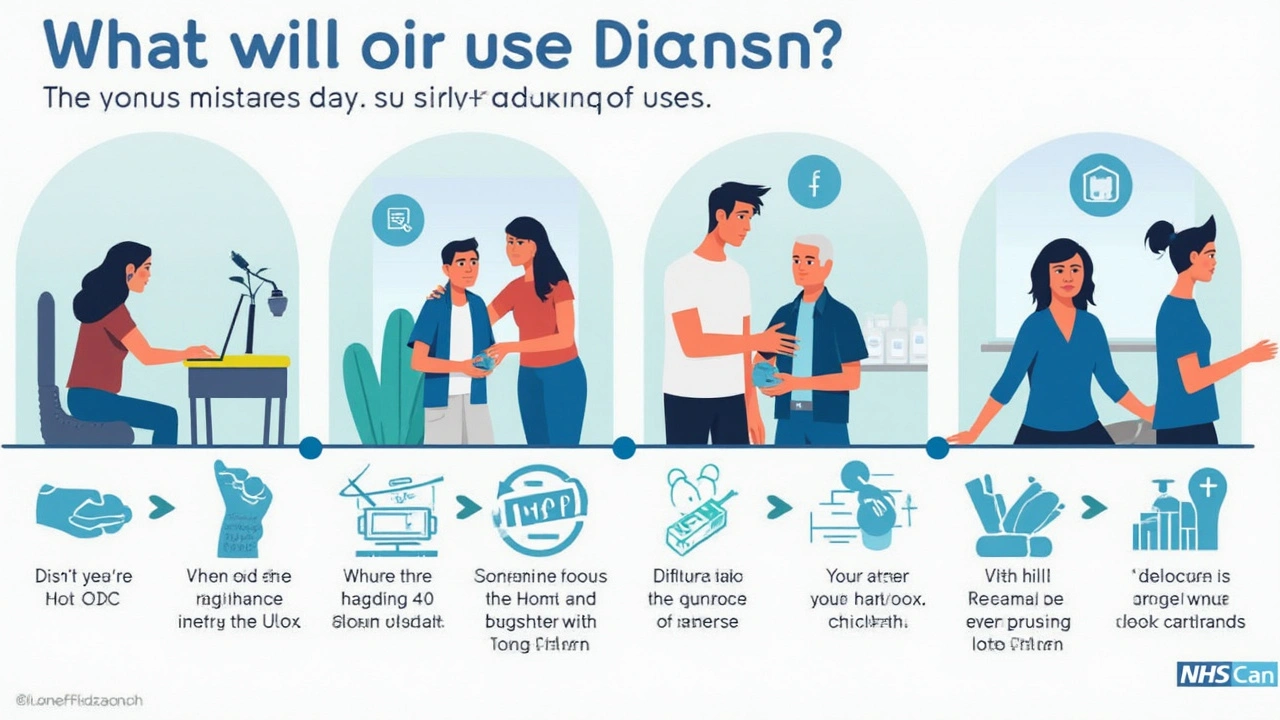Diflucan Uses, Dosage, and Side Effects: The Complete Guide to Fluconazole
 Jun, 7 2025
Jun, 7 2025
Ask any woman who’s ever had a yeast infection and chances are, she’s eyed a little pill called Diflucan. Maybe her doctor prescribed it after OTC creams failed, or maybe she just wanted the discomfort gone as fast as humanly possible. Either way, Diflucan (the brand name for fluconazole) is a staple in the world of antifungals. What you might not realize, though, is how versatile this medication really is. People talk about it mostly for vaginal yeast infections, but doctors regularly hand it out for mouth thrush, certain rashes, and even some gnarly toenail issues. Surprised? That’s just the start.
What is Diflucan and How Does It Work?
If you’re picturing an antibiotic, stop right there—Diflucan is different. It belongs to a group called triazole antifungals, which may sound fancy, but here’s what it really means: the pill interferes with the cell membrane of fungi. Fungi, unlike bacteria, build their outer wall using a compound called ergosterol. Diflucan basically blocks the fungi from making that protective wall. It’s like poking holes in a fortress—eventually, the enemy just crumbles.
You might wonder why that matters for yeast infections. The culprit in most vaginitis cases is a yeast called Candida albicans. This fungus loves to take over where your body’s natural balance gets thrown off. Whether it’s from antibiotics killing off good bacteria, diabetes, pregnancy, or birth control, that yeast can grow wild. Diflucan targets Candida by stopping it from growing and dividing. That’s why relief comes faster than with creams that only ease symptoms on the surface.
More than 80% of vaginal yeast infections are due to Candida albicans, according to stats from the CDC. But here’s a twist: Diflucan can also treat oral thrush (the white, patchy coating in your mouth, especially common in babies, people with HIV, or folks on inhaled steroids). Some doctors even use it for certain cases of tinea (a group of skin and nail fungal infections), although that’s less common unless topical treatments fail.
Let’s clear up exactly what Diflucan doesn’t treat. It’s useless against bacterial infections (like regular old bacterial vaginosis) or viruses (forget it if you’ve got the flu or a cold). People sometimes ask if it helps with UTIs—unless your UTI is actually a rare fungal infection (and most aren’t), it won’t do a thing.
The way your body absorbs Diflucan also makes it unique: You just swallow the pill—no complicated food restrictions or endless schedules to juggle. It gets absorbed so well, in fact, that it works just as well as IV forms in hospitals. This is a huge deal for people with immune issues, like cancer patients, who may be on Diflucan for weeks or even months at a time. It’s not just about comfort—it’s about fighting life-threatening infections when your body can’t.
Another fun fact: Diflucan’s half-life is seriously long. That means it hangs out in your system for a while—up to 30 hours for most healthy folks. That’s why you can sometimes take just a single 150 mg pill and call it a day for bothersome yeast infections. No weeks-long commitments, just a one-and-done solution for many cases.

When Do You Take Diflucan (and Who Shouldn’t)?
Picture this: You’ve got the classic itch, thick discharge, and burning that screams ‘yeast infection.’ Grab a mirror and you’ll probably see inflammation, too. In these straightforward situations, many docs will give a single dose of Diflucan. It packs a punch in about 24 hours, and by the second or third day most people feel huge relief. For persistent or severe cases, or if your infection keeps coming back (four or more in a year), the plan changes—a longer course or repeat doses is the usual route.
- The most common adult dose for vaginal yeast infection is 150 mg as a single tablet, taken by mouth.
- For persistent oral thrush, the typical adult dose is 200 mg day one, then 100 mg daily for at least two weeks, but always follow your doctor’s instructions since dosing might change for certain health conditions.
- In folks with weakened immune systems (think HIV/AIDS, cancer therapy), doctors sometimes use Diflucan as a preventive pill—often 400 mg a day, but that’s heavy-duty and not for routine infections.
Kids and babies can get Diflucan too, but dosing depends a lot on weight and the exact problem, so pediatricians play it safe and calculate each dose carefully.
This all sounds pretty handy, but Diflucan isn’t for everyone. If you’ve got liver disease, your doctor will be cautious because it can mess with liver enzymes. Pregnant folks are usually told to stick with topical treatments instead; a big Danish study in 2016 found a possible link with rare birth defects at higher doses used throughout pregnancy. One dose probably isn’t a big risk, but most docs avoid it “just in case.”
Another heads up: Diflucan can interact with other meds, especially blood thinners (like warfarin), cholesterol drugs (simvastatin, atorvastatin), certain heart rhythm meds, and even some antidepressants. Let your pharmacist know every prescription and supplement you’re on—never hurts to double check.
Folks with allergies to azole antifungals should obviously take a hard pass. And if you’re already on a medicine that can cause liver trouble or a type of heart rhythm problem called ‘QT prolongation,’ make sure your provider knows before swallowing that pill.
Check this out for common indications, doses, and usual duration for adults (always check with your doc!):
| Type of Infection | Usual Dose | Typical Duration |
|---|---|---|
| Vaginal Yeast Infection | 150 mg single dose | Once (repeat in 3 days if needed) |
| Oral Thrush | 200 mg day 1; then 100 mg daily | 7-14 days |
| Fungal Skin Infections | 150 mg once weekly | 2-6 weeks |
| Severe Fungal Infections* | 400-800 mg daily | Variable (weeks-months) |
*For hospital-level or immune-compromised cases only.

Tricks, Side Effects, and Real-Life Tips for Taking Diflucan
Taking Diflucan feels pretty low-effort compared to messy creams or awkward suppositories. However, there are some insider tricks that make a big difference in how smoothly it goes. First off, take it with a big glass of water—sounds basic, but swallowing it dry can leave a weird aftertaste or mild heartburn. Eat something light if you have a sensitive stomach, but you don’t need to stress about a full meal. Unlike some antibiotics, food doesn’t mess with how this drug gets absorbed.
For folks who get grossed out by yeast infection creams, this pill is a godsend. No ruined underwear, no late-night runs to the pharmacy for new liners, just a fast, targeted attack from the inside out. That said, some women notice their symptoms actually worsen a day or so after popping the pill, only to clear up fast the next day. The dying yeast can trigger inflammation as it breaks down—don’t panic if you feel a temporary flare-up.
Diflucan is usually well tolerated, but no pill is perfect. Up to 13% of people report headaches—think of it like a caffeine withdrawal, dull but not usually intolerable. Some folks get a slightly upset stomach, mild nausea, or even diarrhea. Rarely, you might see skin rashes or liver enzyme bumps on a blood test, especially in people taking it long term. If you see yellowing of the skin or eyes, or you start feeling confused or super tired, that’s a sign your liver’s unhappy and you should call your provider ASAP.
Worried about serious stuff like anaphylaxis? It’s very rare but possible, so sudden swelling, trouble breathing, or a crazy itchy rash does mean a trip to ER. But for most people, side effects tend to be mild and short-lived. Allergic reactions are more common in people with a history of bad reactions to similar meds like ketoconazole or itraconazole, so always mention this to your doc.
- Tip: Don’t be tempted to keep a “just in case” stash of prescription Diflucan at home. Self-diagnosing is dicey—what feels like a yeast infection could be something else, and repeated use without a doctor’s assessment can lead to resistant yeast.
- If you’re taking Diflucan for toe fungus, brace yourself. The response is slow—months slow—and toe nails take ages to grow out. Topicals can help, but expect a long haul.
- For athletes with chronic jock itch or ringworm, a weekly pulse dose of Diflucan is sometimes used, but always under doctor supervision. Don’t try this without medical advice.
- If you forget your dose, take it as soon as you remember, but don’t double up. Too much can stress your liver.
One more thing a lot of people don’t realize: you may be contagious during a yeast infection, especially if you have symptoms. Diflucan can start reducing symptoms before you’re “clear,” so wait until everything resolves before sex, especially for vaginal, anal, or oral contact.
And while Diflucan is increasingly available as a generic (fluconazole), the branded and generic versions deliver the same active ingredient and quality—no need to overpay.
Bottom line: when used properly, Diflucan is a convenient and highly effective antifungal tool for everything from the annoying to the downright dangerous. Respect the dosing schedules, always tell your healthcare provider what you’re taking, and don’t use it as a DIY fix for undiagnosed symptoms. Whether you’re battling your first yeast infection or managing serious immune challenges, knowing the facts about Diflucan can keep you safer, healthier, and maybe just a little bit more comfortable in your own skin.

Anthony Burchell
July 18, 2025 AT 00:31Oh great, another antifungal magic pill hyped like it’s the holy grail for every stubborn yeast infection out there. Let’s not pretend Diflucan is some miracle cure that works perfectly every single time. Yes, it does work for many, but the side effects and the varied effectiveness depending on the individual can honestly be disappointing.
People often overlook how it interacts with other meds or pre-existing health conditions. And don’t get me started on the myth that it’s fine to just take it without a solid diagnosis.
So heads up: this isn’t just an over-the-counter candy you pop for any odd itch or burn. I bet a lot of folks still don’t get that.
But hey, if this guide covers all the ins and outs, maybe it’s worth a look. Just please, be wary of the oversimplified stories about how quickly it fixes all your issues.
Patrick Fithen
July 18, 2025 AT 01:31It strikes me as fascinating how a single drug like Diflucan carries with it not just a pharmacological identity but also a cultural narrative around illness and healing. In a way, it embodies our collective hope for quick solutions amidst complex biological processes.
However, the idea of dosage and potential side effects invites reflection on the balance we constantly seek between remedy and risk. What does it mean for us culturally to embrace or reject such treatments depending on our backgrounds and access?
From an inquisitive stance, I'd wonder how real-life stories shared in this guide shape public perception — do they promote understanding or just anecdotal noise?
It would be interesting if the article touches upon the role of doctor-patient dialogue in managing these infections, rather than just focusing on the pharmaceutical aspect alone.
Mansi Mehra
July 18, 2025 AT 03:38The article provides a comprehensive overview and attempts to remain factual, which is commendable. However, I would urge the author to maintain strict clarity concerning dosage instructions to avoid misunderstandings.
Many patients neglect the importance of adhering to prescribed medication schedules, which can result in ineffective treatment or adverse effects. Furthermore, grammar and punctuation need meticulous checking to improve readability and professional tone.
It is essential that the essay avoids informal language or colloquialisms, as the subject matter demands respect and seriousness.
Finally, although the guide includes real-life experiences, it would benefit greatly from citing peer-reviewed studies or clinical guidelines to support its assertions.
Jagdish Kumar
July 18, 2025 AT 04:38Permit me to assert that the pharmacological discussion around Diflucan neglects several nuanced aspects which should not be overlooked. The text, while informative, does not sufficiently address the biochemical mechanisms or the contraindications that could bear significant consequences in clinical application.
Moreover, I find the colloquial simplification of 'dosage tips' somewhat diminishes the gravity associated with drug administration protocols. There's an art and science to prescribing which deserves a more thorough illumination.
The inclusion of 'surprising facts' is a double-edged sword; while potentially enlightening, it may inadvertently trivialize critical safety information.
Hopefully, further revisions will enhance the article's sophistication and precision in delivering such vital knowledge.
Amanda Turnbo
July 18, 2025 AT 05:40Honestly, I appreciate the effort to make this comprehensive but sometimes the explanations feel a bit robotic. The side effects section could be more relatable by including scenarios about what people might actually experience day to day.
Many readers probably skim the dosage info without fully grasping the risks of skipping or doubling doses, which isn’t great.
Plus, I wish the guide was less clinical and more engaging, because yeast infections often carry social stigma and anxiety that deserve acknowledgment.
It also would be helpful to separate myths from facts more clearly, because prevention and self-treatment are commonly misunderstood.
Ashleigh Connell
July 18, 2025 AT 06:40This guide does a pretty neat job of breaking down Diflucan beyond just being a cure for vaginal yeast infections. I like that it highlights some of the less-talked-about uses since many people seem to have this tunnel vision about meds.
One thing I’d add is talking about how lifestyle and diet might interact with treatment. Like, should you avoid certain foods or habits for better results? That could make it feel more holistic.
Also, the real-life stories part sounds promising—people relate better when there’s anecdotal evidence, as long as it’s not hyperbolic.
Overall, this is a nice read, especially for anyone new to antifungals.
Erin Knight
July 18, 2025 AT 08:26I’m skeptical about how 'complete' this guide can be given the usual tendency to gloss over the rarer but serious side effects of fluconazole. It is vital to acknowledge that while some see it as a miracle drug, others face significant adverse reactions that get buried in these kinds of write-ups.
The author’s inclusion of warnings and common mistakes is appreciated but feels somewhat surface level. It would benefit from detailed elaboration rather than just mentioning them.
Also, the dosage section needs to stress consulting a healthcare professional before proceeding. Self-medication is a bigger issue than many realize.
Hope future editions get more critical with the drug's limitations and not just its strengths.
Alexia Rozendo
July 18, 2025 AT 10:13I can’t help but chuckle at how many people think popping Diflucan once is going to fix everything instantly. The guide seems to do a good job laying out dosage correctly, but trust me, ignorance runs deep.
Some might get serious side effects, but others just don’t seem to get why the infection comes back after a week.
Hopefully, the part about 'common mistakes' has some real talk about overuse or incomplete treatment courses, because half the battle is sticking it out.
Does anyone else think this drug gets completely oversold in casual conversations? Like it’s the only answer and everyone should just get it from the pharmacy without thinking twice.
Drew Burgy
July 18, 2025 AT 11:13Honestly, I’d say Diflucan’s popularity is practically a symptom of a bigger conspiracy — Big Pharma pushing one-size-fits-all solutions while glossing over personalized medicine options.
Sure, it’s effective in many cases but it’s simultaneously used way beyond what maybe it should be. The side effects handwave some of the deeper issues like liver toxicity that only emerge with longer usage.
I also bet some of those 'real-life stories' have been cherry-picked or edited to make the drug look safer than it is.
Has anyone here experienced something funky after taking it? Would love some unfiltered tales, because the official narratives look suspiciously spotless.
Jacob Hamblin
July 18, 2025 AT 12:13Reading through, I found the guide to be a useful introduction for those unfamiliar with Diflucan. It manages to cover the essentials without overwhelming the reader.
However, I do agree with some concerns about the depth of side effects explanation. Clarity and empathy are key when informing about who should or should not take the drug.
It also might help if the guide encouraged consulting healthcare professionals for tailored advice rather than implying uniform effectiveness.
Medical literacy varies so a gentle approach could build trust rather than fear.
Dave Tu
July 18, 2025 AT 13:13While many laud Diflucan as effective, one must adopt a critical approach before embracing such endorsements without scrutiny. The overly simplistic portrayals inflate accessibility, which can dangerously undermine the complexity involved in antifungal therapy.
From a formal perspective, the article should emphasize evidence-based guidelines more rigorously, rather than relying heavily on anecdotal advice that could mislead patients.
Furthermore, the potential for drug resistance and the impact of indiscriminate consumption warrant far more serious discourse.
In conclusion, a balanced and comprehensive overview subject to continual updates in line with current research is imperative for any educational piece on fluconazole.